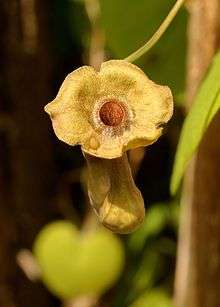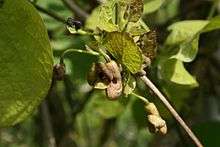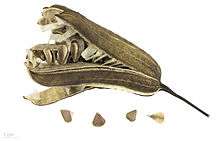Aristolochia macrophylla
| Aristolochia macrophylla | |
|---|---|
 | |
| Scientific classification | |
| Kingdom: | Plantae |
| (unranked): | Angiosperms |
| (unranked): | Magnoliids |
| Order: | Piperales |
| Family: | Aristolochiaceae |
| Genus: | Aristolochia |
| Species: | A. macropylla |
| Binomial name | |
| Aristolochia macrophylla Lam. | |
| Synonyms | |
| |
Aristolochia macrophylla, Dutchman's pipe or pipevine, is a vine native to the eastern United States. Aristolochia macrophylla belongs to the Aristolochiaceae family of plants and is found primarily along the Cumberland Mountains and Blue Ridge Mountains in the eastern portion of the United States, as well as Ontario, Canada. This species of plant has received considerable attention in the past few decades for the discovery of a potent compound called aristolochic acid, which has been the focus of debate due its harmful side effects.
Description

This vine is a flowering plant that can grow up to 30 feet (9 m) at a relatively fast rate. In the early stages of its development, the vines of Aristolochia macrophylla are very stiff and rigid, but as the plant develops, the vines become much more flexible and stable. This is because the plant is composed of sclerenchymatous cortical tissue, which has an outer cylinder, or layer, as well as an inner cylinder. Years of research showed that it is the outer sclerenchymatous cylinder that gives the stems of this plant its mechanical stability. This species flowers between the months of June and August in the U.S. with its seeds ripening in September and October. The large heart-shaped leaves can range between 6–12 inches (15–30 cm). These dark green leaves can overlap and cover an arbor or trellis. Plants can also be used to provide extensive covers for pillars, sun porches, fences, walls as well as other things.[1][2]
Flowers and fruit

The reason why Aristolochia macrophylla is often referred to as "Dutchman’s pipe" is because of the 2 inches (5 cm) yellowish-green flowers they produce. Each flower also sprouts from the calyx mouth to further produce 3 brownish-purple lobes. It is this complex of the flowers and lobes that gives the species a close resemblance to Dutch smoking pipes. The flowers may be hidden by the thick vegetation of the pipevine.[2]
The flowers start to open up in May and June in the U.S. and the fragrant flowers attract local insects. Once an insect has arrived to the flower, the insect is trapped inside a tube, which forces the insect to carry out pollination. Once pollination has been completed and time has passed since pollination, a fruit resembling a cucumber, between 6-10 cm in height, and 3 cm in diameter is produced. The fruit then ripens, usually around September in the U.S., turns brown and splits into six fragments to disperse its small, triangular seeds.[3]
Distribution
Aristolochia macrophylla has a relatively wide distribution. It is found from Maine to Alabama, and reaches all the way to Georgia, Tennessee and Kansas. The plant species generally ranges from the Eastern region of the United States up to Michigan, with the exception of Ohio, Indiana and Illinois, and reaches the southeast up until Florida where the presence of this species comes to an abrupt halt. It is also common in Mississippi and Alabama all the way up north to Maine and Ontario, Canada. Aristolochia macrophylla is considered to be a threatened species in Maryland. Although the species is not endangered yet, the pipevine could be well on its way to endangerment if measures are not taken to protect this species from the negative consequences of deforestation and other aspects of human disturbance.[4]
Habitat and ecology

Aristolochia macrophylla is native to the southeast of the United States, however it is also found in the northeast, as well as Ontario, Canada. This plant species resides largely in the Cumberland and Blue Ridge Mountains of southeastern United States. They are native to wooded slopes, gaps, as well as ravines which are mainly in the Cumberland and Blue Ridge Mountains from West Virginia, to Kentucky, Tennessee and northern Georgia. Pipevine eventually spread to other parts of the eastern coast of the United States. Aristolochia macrophylla is naturally found in light sandy soil, medium loamy soil and heavy clay soils, with a preference for drained soils. This species is also primarily found in alkaline soils with high pH. Essentially, Aristolochia macrophylla has a strong preference for moist soils, while being very intolerant to dry soils.[5][6]
Toxicity
Aristolochia macrophylla contains the natural substance aristolochic acid. Aristoclochic acid is found in all plants of the Aristolochiaceae family. Aristolochic acid is a very dangerous compound in that this acid is a potent mutagen and carcinogen that can cause urological cancers as well as permanent kidney failure. Consumption of aristolochic acid can also induce uterine bleeding. Because of this, the FDA has warned consumers to avoid products that contain, or possibly contain, aristolochic acid. Even though aristolochic acid has been found to expedite and arouse the activity of white blood cells, speed the healing of wounds, and possibly be used in concurrence with chemotherapy and radiation therapy, this compound is highly carcinogenic and is very deleterious to renal health. A concoction produced from the root of the plant has been used to treat swelling of the extremities. However, because of the harmful effects associated with the consumption of plants from the Aristolochiaceae family of plants, the roots of Pipevine are no longer exploited for its medical benefits.[7][8]
Even though the plant has been known to have some anticancer and antiseptic properties, the aristolochic acid contained within the plant still remains controversial. Therefore, doctors and scientists have urged the public to not consume any products that contain this potent mutagen, as scientists have seen a surge in the rate of cancer, particularly in the urinary tract, as well as kidney failure, in individuals who have consumed this species, or plants from the same family. Individuals have also consumed concoctions from roots of the plants, as well as the roots themselves, to treat swelling of the lower extremities in the past. However these concoctions are not produced or consumed anymore due to the dangerous health effects associated with consuming these plants.[8]
References
- ↑ Masselter, Tom; Thomas Speck (2008). "Quantitative and qualitative changes in primary and secondary stem organization of Aristolochia macrophylla during ontogeny: functional growth analysis and experiments". Journal of Experimental Botany. 59 (11): 2955–67. doi:10.1093/jxb/ern151. PMC 2504350
 . PMID 18573799. Retrieved 2014-05-05.
. PMID 18573799. Retrieved 2014-05-05. - 1 2 "Aristolochia macrophylla - Plant Finder". Aristolochia macrophylla - Plant Finder. Retrieved 2014-05-05.
- ↑ "Dutchman's pipe - Aristolochia". Dutchman's pipe - Aristolochia. Retrieved 2014-05-05.
- ↑ "Plants Profile for Aristolochia macrophylla (Pipevine)". Plants Profile for Aristolochia macrophylla (Pipevine). Retrieved 2014-05-05.
- ↑ "Aristolochia Birthwort PFAF Plant Database". Aristolochia Birthwort PFAF Plant Database. Retrieved 2014-05-05.
- ↑ "Aristolochia macrophylla Dutchman's Pipe from American Beauties". Aristolochia macrophylla Dutchman's Pipe from American Beauties. Retrieved 2014-05-05.
- ↑ "Herb Danger - Aristolochic Acid Warning.” MedicineNet. Web. 2014-05-05.
- 1 2 "Wild Edible and Medicinal Plants". Wild Edible and Medicinal Plants. Retrieved 2014-05-05.